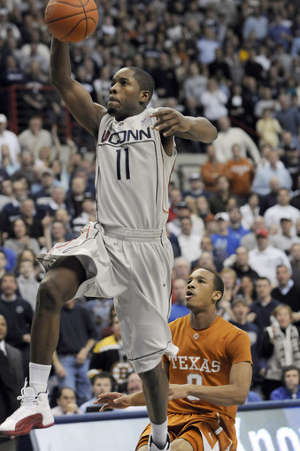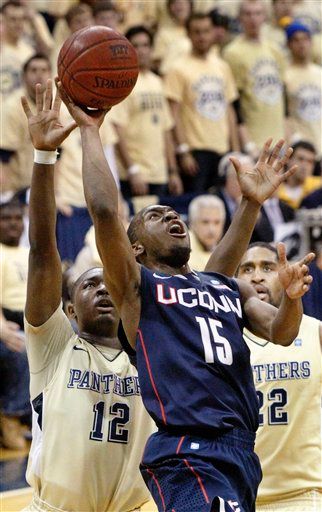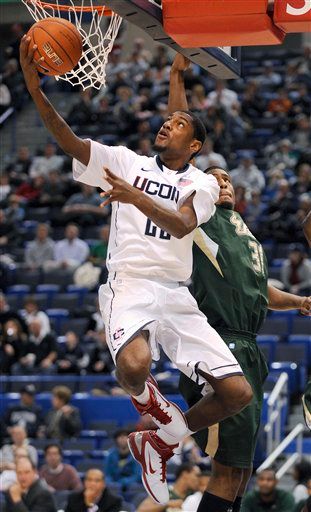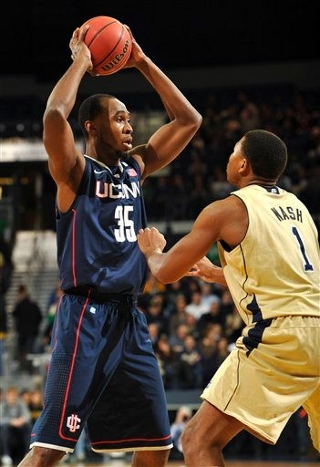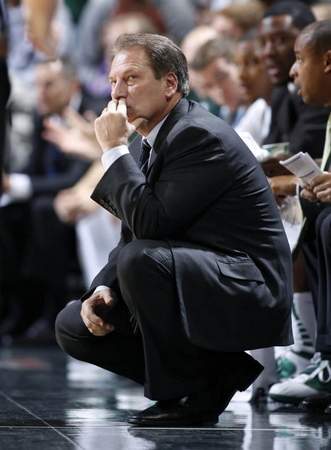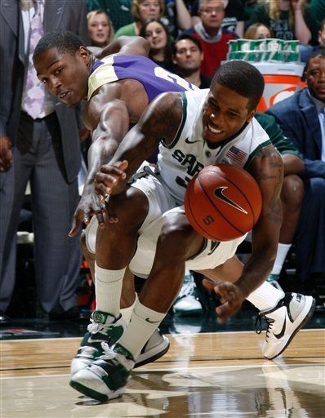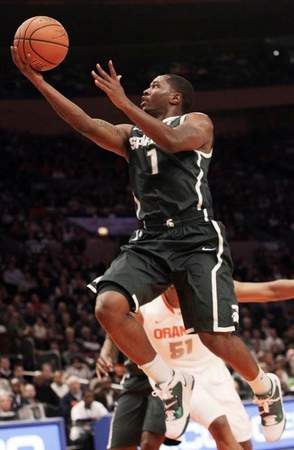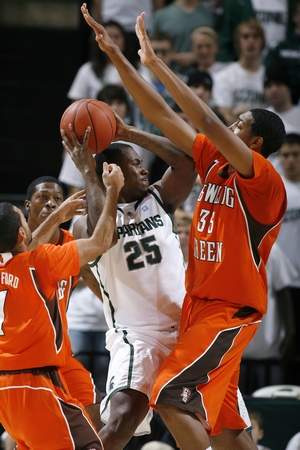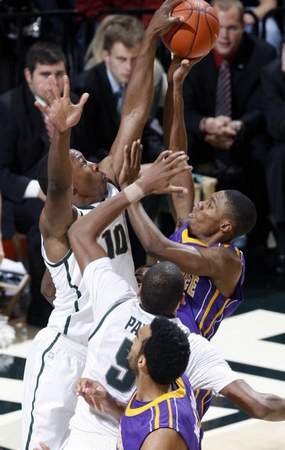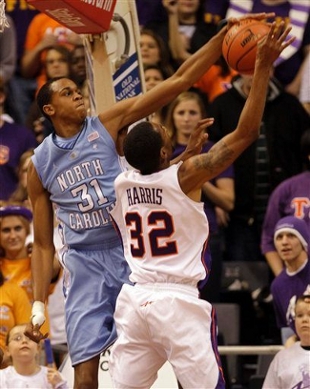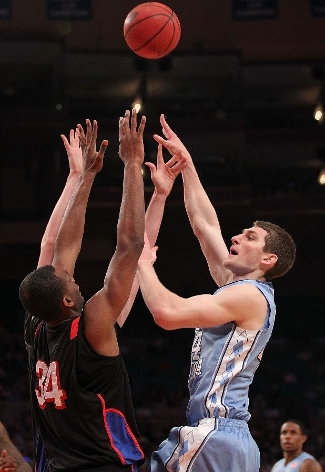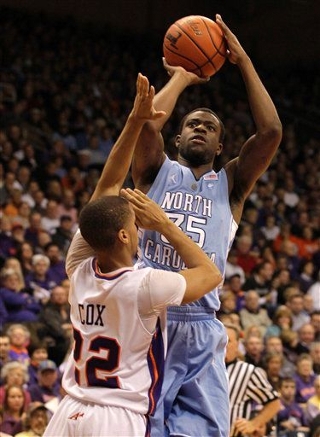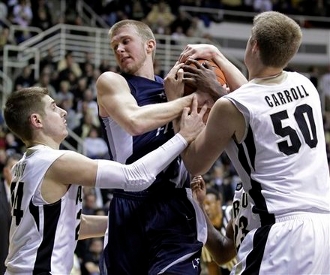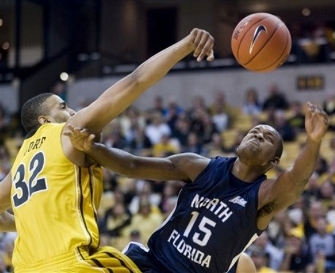Frank Erwin Center | Austin, TX | Tip: 2:30 P.M. CT | TV: ESPN A year ago, a road game against UConn served as the turning point in a disappointing season for the Texas Longhorns, a season in which they ascended to the nation’s No. 1 ranking before spiraling into a free-fall that ended with a first-round NCAA exit.
The Huskies blew past Texas in Storrs last season When the Longhorns blew a 10-point second-half lead in Storrs last season, ultimately losing to the Huskies by 14 points, they had already suffered their first loss of the year to Kansas State. But the team’s inexplicable collapse in the final 20 minutes against UConn served as a microcosm of a season in which the team had an equally-frustrating implosion down the stretch. With UConn losing both Stanley Robinson and Jerome Dyson in the off-season, this year’s match-up between the two teams seemed like an easy chance for Texas’ revenge. The Huskies entered the season as one of the youngest teams in the country, with a frontcourt surrounded by question marks. Then, the Maui Invitational happened. Kemba Walker, who spent his summer working hard in NBA skills camps and with the USA Select team, exploded onto the national scene with 90 points in three games, leading his young team to a tournament title with wins over Michigan State and Kentucky. The potential is certainly still there for a Texas revenge win. In recent weeks, the Huskies have struggled as they entered conference play, suffering a pair of road losses to Pitt and Notre Dame, while being forced to overtime by a South Florida team that now holds a 6-10 record. Stat guru Ken Pomeroy gives Texas a 78% chance to win this afternoon, projecting a 74-68 win for the Horns. By the numbers Coached by longtime legend Jim Calhoun, the Huskies are sound on both ends of the court. Their skill on both offense and defense gives them a per-possession scoring differential of 0.218, which ranks 29th nationally. As a point of comparison, the Longhorns rank 15th in that category, holding a 0.264 differential. In eight of the last nine seasons, UConn has led the nation in blocks. The one year they didn’t claim the top spot, they slid all the way down to second. This year, the solid team defense has them blocking shots at a ridiculous pace once again, swatting 18.2% of their opponents shots. While not yet tops in the nation, that mark puts the Huskies at third in D-I basketball. Thanks to that intimidating inside presence, the UConn defense simply doesn’t let teams score easily inside. Their defense is allowing opponents to shoot just 39.5% inside the arc, a mark that is 7th in the nation. The Longhorns come into today’s game just as stout inside, allowing just a 38.6% success rate, good for 3rd in the country. If today’s game settles into a half-court affair, it will either be a low-scoring battle or a showcase of three-point shooting.
Kemba Walker has been practically unstoppable On offense, the Huskies make their possessions count. Their turnover rate is a scant 17.8%, 38th in the country, while their offensive rebounding percantage is 4th in the country. UConn grabs 43.5% of their misses, but those numbers may be deceptive thanks to an incredibly weak non-con schedule. The Huskies have played five opponents who place in the bottom 100 of Ken Pomeroy’s ratings, and the team’s recent foray into Big East play seem to indicate that perhaps that schedule left them a little unprepared. In UConn’s last two games — a road loss to Notre Dame and an overtime win at home over South Florida — the team grabbed just 31.5% of their offensive rebounding chances. Meet the Huskies If you’ve watched any college basketball at all this season, Kemba Walker needs no introduction. The junior guard is averaging 26.1 points per game, while his quick hands on defense have led to 2.4 steals per game. The biggest knock on Walker’s game coming into the season was his lack of a long-range shot. A lightning-quick guard, Kemba was often stifled by defenses who sagged off thanks to his inability to knock down threes and long-range jumpers. As a member of both Chris Paul’s and LeBron James’ skills camps this summer, Walker put in tons of hours, and developed a long-range threat that has made him nearly unstoppable. Shooting 35.9% from behind the arc this year, Walker now forces defenses to play him tight, allowing him numerous opportunities to blow by and score at the rim or on pull-up jumpers. Inside, Alex Oriakhi has made huge strides in his sophomore season. The Huskies desperately needed a post presence entering the season, and he has improved his offensive game enough to make an impact. Oriakhi has always been a solid rebounder, but his 10.5 points per game this season are more than double his five point-per-game output from last season. With 8.4 boards per contest, the sophomore is by far the leading rebounder on the team, and his work on the offensive glass is key to keeping the UConn offense clicking. Jeremy Lamb is the only member of the deep six-man freshman class who has started every game, and his length and athleticism are invaluable at the wing. He’s scoring 7.7 points a night while pulling down 4.8 boards, and his long arms help when he’s out of position on defense.
Roscoe Smith is one of UConn’s highly-touted freshmen Fellow freshman Roscoe Smith has joined Lamb in the starting lineup for UConn’s first three Big East conference games. He’s another lengthy, athletic kid, and he embodies the strong, physical post defense that UConn is famous for. This season, he’s averaging nearly two blocks a game and is second on the team with 32 offensive rebounds. The other UConn big man who has cracked the starting lineup in Big East play is senior Charles Okwandu. The seven-foot Nigerian product isn’t much of an offensive threat, but he runs the floor well in transition, making it difficult for teams to get open looks even on the fast break. While his raw block numbers aren’t tops on the team, tempo-free stats reveal that Okwandu is the best shot blocker on the team. In his limited minutes, the senior was blocking 12% of all opportunities heading into the Notre Dame game. Had he played enough minutes to qualify for the leaderboard, that would make Okwandu the 17th-best shot blocker in all of D-I basketball. Coming off the bench, UConn has an exciting freshman guard in Shabazz Napier. Like Walker, he’s incredibly quick with the basketball, and he isn’t afraid to shoot from anywhere on the floor. He brings a much-needed three-point threat to a team that struggled behind the arc last season, and he’s averaging nearly two steals a game. The Longhorns will want to be careful when pushing the ball up after missed UConn baskets, because Napier loves to steal the initial outlet pass and turn it into an easy layup. Sophomore forward Jamal Coombs-McDaniel also comes off the bench for Coach Calhoun, and he provides even more height at the wing. He gives the Huskies a very good rebounder from the 3 or the 4 spot, but coaches are hoping he can also add a three-point threat to his arsenal. So far this season, Coombs-McDaniel is just 6-of-27 from behind the arc, and it’s limited him to about 15 minutes a game. Freshman Niels Giffey comes to Storrs by way of Berlin, Germany, and he brings the outside shot that so many European players love. Giffey is yet another really tall wingman for UConn, checking in at 6’7″, and his height makes him a valuable defender against teams with solid outside shooters. Big man Tyler Olander is another freshman for UConn, and he started a handful of games for the team at the beginning of the year. Now, he’s relegated to the bench, and his minutes per game have dropped to about 13 per contest. He’s not a flashy player, but he’s a hard-nosed guy who scraps for rebounds. In the offseason, senior Donnell Beverly was being pegged as a potential leader in the backcourt, someone who could work with Walker and provide a steady hand when the young team hit speedbumps. As it’s turned out, Napier and Lamb have contributed almost immediately, and Beverly hasn’t been needed for more than nine minutes a game. Statistically, he hasn’t been much of a factor this season, but he will give the younger guards a few minutes of rest this afternoon. The most recent addition to the team is seven-footer Enosch Wolf, another European product who is still a very raw talent. His enrollment at UConn was delayed by a semester, so he missed out on practically the entire non-conference slate, and as a result, he doesn’t have a real role in the rotation. Enosch has only played six minutes per game in his first three appearances, but his nasty, tenacious play inside will undoubtedly be a key for the team in years to come. Keys to the game Make Walker work for his points – It’s no secret that Kemba Walker is going to score a bunch of points this afternoon. He had 12 straight games in which he scored at least 20 points, and the streak was finally broken when he chipped in “only” 19 in the loss to the Irish. What seems to be key, however, is how often Walker keeps the ball away from the rest of the offense when he’s scoring. When Walker takes more than 40% of his team’s shots, they are 1-2 this season, with the one victory being a narrow four-point win over Wichita State in Maui. If the Longhorns challenge Walker’s shots and provide good help defense when he inevitably beats his man, they can make it much tougher for him to earn those points. If he is taking 20-plus shots tonight, Texas should find itself on top when the buzzer sounds. Keep the Huskies off the offensive glass – Connecticut makes teams pay by extending their possessions on the offensive end. Make a good stop against the Huskies, and you’re often frustrated by an offensive board leading to an easy putback or an opportunity for the offense to re-set. Against quality competition in their last three games, the UConn frontcourt has looked much more mortal than they did in the first two months of the season. If Texas can limit the second and third-chance points, it will be tough for UConn to steal a road win.
Charles Okwandu isn’t much of an offensive threat Attack inside – The frontcourt was the big question mark coming into the season for the Huskies, and it’s still a bit of an enigma as the calendar turns to 2011. Alex Oriakhi has seen a severe drop in his production since Big East play began, averaging just 7.6 points and 3.3 boards per game. While many guys would love to have that line, Oriakhi started the season with three double-doubles in his first five games, including ones against Michigan State and Kentucky. The biggest limiting factor for Oriakhi in conference play has been foul trouble, as he played just 19 minutes against Pitt and 23 against Notre Dame. If the Longhorns can attack Oriakhi and saddle him with fouls, the Huskies will be forced to rely on Okwandu and Wolf, two guys who lack the offensive threat that Oriakhi brings to the court. Beat the defense – As with Michigan State just a few weeks ago, the best way to beat the skilled UConn defense is to push the ball in transition and score on the break and on the secondary break. The Huskies do a good job of staying in front of their men in the half-court, and solid help defense allows them to block a ton of shots when opponents do actually beat their man. As Notre Dame proved in a win over UConn on Tuesday night, if Texas can beat the defense down the floor, they will find it much easier to knock off the Huskies. |








